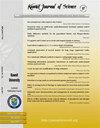Temperature variability and its governing mechanisms within the Jailolo Strait, Indonesia
IF 1.1
4区 综合性期刊
Q3 MULTIDISCIPLINARY SCIENCES
引用次数: 0
Abstract
Long-term reanalysis data from the Bluelink ReANalysis 2020 (BRAN2020) are used to investigate temperature variability from 2010 to 2020 in the Jailolo Strait–Halmahera Sea, which is part of the Indonesian Throughflow (ITF) eastern route. The analysis shows that net surface heat flux (NSHF) mainly affects semiannual mixed layer temperature (MLT) variability. Vertical turbulent mixing cools the mixed layer from below, while the vertical and horizontal advection have less impact on the MLT heat budget. In the upper thermocline (40–100 m), two temperature minima occur: one in April due to outflow to the Pacific Ocean, and another in August due to uplifted water. Different cooling processes mark the dominant annual variation in the mid thermocline (100–150 m depth) and the lower thermocline (150–200 m). The cooling process is mainly associated with the transport from the Pacific Ocean into the Indonesian Seas (inflow) in the mid-thermocline, while it is generally related to the outflow transport in the lower thermocline. Interannual temperature variation is marked by the relatively colder (warmer) sea surface temperature and shallowing (deepening) thermocline during the El Niño (La Niña) period, which is associated with the upwelling (downwelling) Rossby wave propagation. It is also found that the colder (warmer) temperature in the upper 200 m during the El Niño (La Niña) period correlates with the weaker (stronger) inflow from the Pacific Ocean into the Indonesian Seas.
印尼Jailolo海峡内的温度变化及其控制机制
使用蓝链再分析2020 (BRAN2020)的长期再分析数据来研究2010年至2020年Jailolo海峡- halmahera海的温度变化,该海峡是印度尼西亚通流(ITF)东线的一部分。分析表明,净地表热通量(NSHF)主要影响半年混合层温度(MLT)的变化。垂直湍流混合从下方冷却混合层,而垂直和水平平流对MLT热收支的影响较小。在上层温跃层(40-100米),有两个温度最低值:一个在4月,由于向太平洋流出,另一个在8月,由于上升的水。不同的冷却过程标志着中温跃层(100 ~ 150 m)和下温跃层(150 ~ 200 m)的年变化占主导地位,冷却过程主要与中温跃层从太平洋向印尼海的输送(流入)有关,而一般与下温跃层的流出输送有关。El Niño (La Niña)期海表温度相对偏冷(偏暖),温跃层变浅(变深),年际温度变化特征与上升(下降)的罗斯比波传播有关。在El Niño (La Niña)期间,上层200 m较冷(较暖)的温度与太平洋流入印尼海的较弱(较强)气流相关。
本文章由计算机程序翻译,如有差异,请以英文原文为准。
求助全文
约1分钟内获得全文
求助全文
来源期刊

Kuwait Journal of Science
MULTIDISCIPLINARY SCIENCES-
CiteScore
1.60
自引率
28.60%
发文量
132
期刊介绍:
Kuwait Journal of Science (KJS) is indexed and abstracted by major publishing houses such as Chemical Abstract, Science Citation Index, Current contents, Mathematics Abstract, Micribiological Abstracts etc. KJS publishes peer-review articles in various fields of Science including Mathematics, Computer Science, Physics, Statistics, Biology, Chemistry and Earth & Environmental Sciences. In addition, it also aims to bring the results of scientific research carried out under a variety of intellectual traditions and organizations to the attention of specialized scholarly readership. As such, the publisher expects the submission of original manuscripts which contain analysis and solutions about important theoretical, empirical and normative issues.
 求助内容:
求助内容: 应助结果提醒方式:
应助结果提醒方式:


